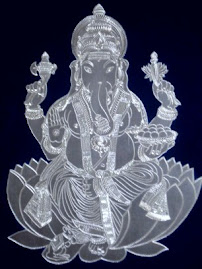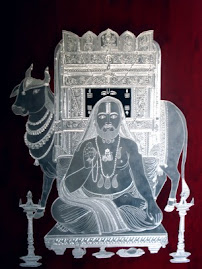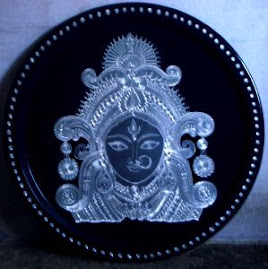Sculpture:Sculpture is three-dimensional artwork created by shaping or combining hard and or plastic material, sound, and or text and or light, commonly stone (either rock or marble), metal, glass, or wood. Some sculptures are created directly by finding or carving; others are assembled, built up and fired, welded, molded, or cast. Sculptures are often painted [1]. A person who creates sculptures is called a sculptor.
Carving Bone carving
Chip carving
EQ carving, an application of equalization in audio mixing
Gourd carving
Ice carving
Ivory carving
Meat carving
Rock carving
Skiing or snowboarding carving style, see carve turn
Stone carving
Wood carving
Metal carving
EngravingEngraving is the practice of incising a design on to a hard, usually flat surface, by cutting grooves into it. The result may be a decorated object in itself, as when silver, gold, steel, or glass are engraved, or may provide an intaglio printing plate, of copper or another metal, for printing images on paper as prints or illustrations; these images are also called engravings.
Engraving was a historically important method of producing images on paper, both in artistic printmaking, and also for commercial reproductions and illustrations for books and magazines. It has long been replaced by photography in its commercial applications and, partly because of the difficulty of learning the technique, is much less common in printmaking, where it has been largely replaced by etching and other techniques.
Traditional engraving, by burin or with the use of machines, continues to be practiced by goldsmiths, glass engravers, gunsmiths and others, while modern industrial techniques such as photoengraving and laser engraving have many important applications.
Other terms often used for printed engravings are copper engraving, copper-plate engraving or Line engraving. Steel engraving is the same technique, on steel or steel-faced plates, and was mostly used for banknotes, illustrations for books, magazines and reproductive prints, letterheads and similar uses from about 1790 to the early 20th century, when the technique became less popular, except for banknotes and other forms of security printing. Especially in the past, "engraving" was often used very loosely to cover several printmaking techniques, so that many so-called engravings were in fact produced by totally different techniques, such as etching or mezzotint.
Engravers use a hardened steel tool called a burin to cut the design into the surface, most traditionally a copper plate.[1] Gravers come in a variety of shapes and sizes that yield different line types. The burin produces a unique and recognizable quality of line that is characterized by its steady, deliberate appearance and clean edges. The angle tint tool has a slightly curved tip that is commonly used in printmaking. Florentine liners are flat-bottomed tools with multiple lines incised into them, used to do fill work on larger areas. Flat gravers are used for doing fill work on letters, as well as most musical instrument engraving work. Round gravers are commonly used on silver to create bright cuts (also called bright-cut engraving), as well as other hard-to-cut metals such as nickel and steel. Burins are either square or elongated diamond-shaped and used for cutting straight lines. Other tools such as mezzotint rockers, roulets and burnishers are used for texturing effects.
History and usage(a) etching needle, (b) scraper, (c) and (d) burnishers, (e) graver, (f) scooper, (g) scraper for mezzotints, (h) stipple graver, (i) roulette for mezzotints, (j) shading tool for mezzotints, (k) roulette for mezzotints, (l) dry-point graver, (m) hammer, (n) dabber for applying the 'ground', (o) brushes for applying varnish (p) calliper compasses
For the printing process, see intaglio (printmaking). For the Western art history of engraved prints, see old master print and line engraving
In antiquity, the only engraving on metal that could be carried out is evident in the shallow grooves found in some jewellery after the beginning of the 1st Millennium B.C. The majority of so-called engraved designs on ancient gold rings or other items were produced by chasing or sometimes a combination of lost-wax casting and chasing.
However the use of engraving to cut decorative scenes or figures into glass vessels appears as early as the first century AD[2], continuing into the fourth century CE at urban centres such as Cologne and Rome[3], and appears to have ceased sometime in the fifth century. Decoration was first based on Greek mythology, before hunting and circus scenes became popular, as well as imagery drawn from the Old and New Testament[3]. It appears to have been used to mimic the appearance of precious metal wares during the same period, including the application of gold leaf, and could be cut free-hand or with lathes. As many as twenty separate stylistic workshops have been identified, and it seems likely that the engraver and vessel producer were separate craftsmen[2].
In the European Middle Ages goldsmiths used engraving to decorate and inscribe metalwork. It is thought that they began to print impressions of their designs to record them. From this grew the engraving of copper printing plates to produce artistic images on paper, known as old master prints in Germany in the 1430s. Italy soon followed. Many early engravers came from a goldsmithing background. The first and greatest period of the engraving was from about 1470 to 1530, with such masters as Martin Schongauer, Albrecht Dürer, and Lucas van Leiden.
Thereafter engraving tended to lose ground to etching, which was a much easier technique for the artist to learn. But many prints combined the two techniques: although Rembrandt's prints are generally all called etchings for convenience, many of them have some burin or drypoint work, and some have nothing else. By the nineteenth century, most engraving was for commercial illustration.
Before the advent of photography, engraving was used to reproduce other forms of art, for example paintings. Engravings continued to be common in newspapers and many books into the early 20th century, as they were cheaper to use in printing than photographic images. Engraving has also always been used as a method of original artistic expression.
Thanks:- Wikipedia, the free encyclopedia
Metal EngravingAluminium sheet
Metal Tools
Glass paints
Brush
Black enamel paint
MethodStick the four corners of the trace of the decided design on the metal sheet. Using a ball pointed pen draw over the trace applying force. As the metal sheet is quite fragile, the impression of the traced out line will be prominent on the aluminium sheet. Since force is applied on the trace, it cannot be used again. Take a designer tool and press over the traced out line turning the wrist to the right and left during each press, so that a designed out line comes on the picture.
Now using the scrape tool, scrape off the aluminium neatly on the design towards one direction without spoiling the outline. So that the picture will have a perfect look. Paint the picture with glass paint. To make the art attractive paint the back ground of the picture with black enamel paint. This is a good piece of art which can be hung in the house, shops, and hotels.
Thanks: www.webindia123.com

















